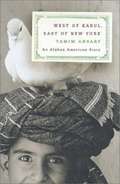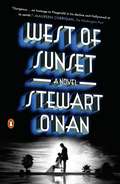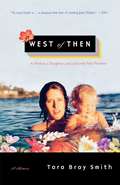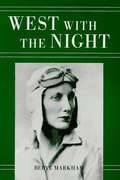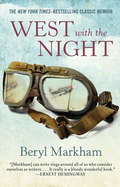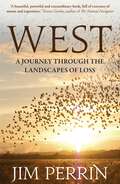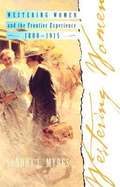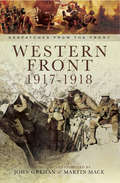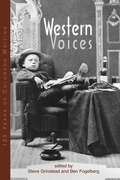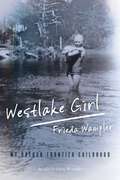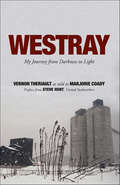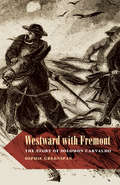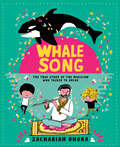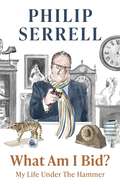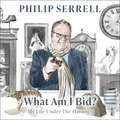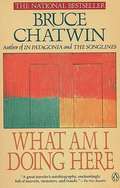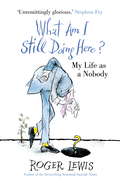- Table View
- List View
West of Kabul, East of New York: An Afghan-American Story
by Tamim AnsaryThe day after the World Trade Center was destroyed, Tamim Ansary sent an anguished e-mail to twenty friends, discussing the attack from his perspective as an Afghan American. The message reached millions. Born to an Afghan father and American mother, Ansary grew up in the intimate world of Afghan family life and emigrated to San Francisco thinking he'd left Afghan culture behind forever. At the height of the Iranian Revolution, however, he took a harrowing journey through the Islamic world, and in the years that followed, he struggled to unite his divided self and to find a place in his imagination where his Afghan and American identities might meet.
West of Sunset
by Stewart O'NanA "rich, sometimes heartbreaking" (Dennis Lehane) novel of F. Scott Fitzgerald's last years in Hollywood In 1937, F. Scott Fitzgerald was a troubled, uncertain man whose literary success was long over. In poor health, with his wife consigned to a mental asylum and his finances in ruins, he struggled to make a new start as a screenwriter in Hollywood. By December 1940, he would be dead of a heart attack. Those last three years of Fitzgerald's life, often obscured by the legend of his earlier Jazz Age glamour, are the focus of Stewart O'Nan's gorgeously and gracefully written novel. With flashbacks to key moments from Fitzgerald's past, the story follows him as he arrives on the MGM lot, falls in love with brassy gossip columnist Sheilah Graham, begins work on The Last Tycoon, and tries to maintain a semblance of family life with the absent Zelda and daughter, Scottie. Fitzgerald's orbit of literary fame and the Golden Age of Hollywood is brought vividly to life through the novel's romantic cast of characters, from Dorothy Parker and Ernest Hemingway to Humphrey Bogart. A sympathetic and deeply personal portrait of a flawed man who never gave up in the end, even as his every wish and hope seemed thwarted, West of Sunset confirms O'Nan as "possibly our best working novelist" (Salon).
West of Sunset
by Stewart O'NanA "rich, sometimes heartbreaking" (Dennis Lehane) novel of F. Scott Fitzgerald's last years in HollywoodIn 1937, F. Scott Fitzgerald was a troubled, uncertain man whose literary success was long over. In poor health, with his wife consigned to a mental asylum and his finances in ruins, he struggled to make a new start as a screenwriter in Hollywood. By December 1940, he would be dead of a heart attack.Those last three years of Fitzgerald's life, often obscured by the legend of his earlier Jazz Age glamour, are the focus of Stewart O'Nan's gorgeously and gracefully written novel. With flashbacks to key moments from Fitzgerald's past, the story follows him as he arrives on the MGM lot, falls in love with brassy gossip columnist Sheilah Graham, begins work on The Last Tycoon, and tries to maintain a semblance of family life with the absent Zelda and daughter, Scottie.Fitzgerald's orbit of literary fame and the Golden Age of Hollywood is brought vividly to life through the novel's romantic cast of characters, from Dorothy Parker and Ernest Hemingway to Humphrey Bogart. A sympathetic and deeply personal portrait of a flawed man who never gave up in the end, even as his every wish and hope seemed thwarted, West of Sunset confirms O'Nan as "possibly our best working novelist" (Salon).
West of Sunset
by Stewart O'NanA "rich, sometimes heartbreaking" (Dennis Lehane) novel of F. Scott Fitzgerald's last years in HollywoodIn 1937, F. Scott Fitzgerald was a troubled, uncertain man whose literary success was long over. In poor health, with his wife consigned to a mental asylum and his finances in ruins, he struggled to make a new start as a screenwriter in Hollywood. By December 1940, he would be dead of a heart attack.Those last three years of Fitzgerald's life, often obscured by the legend of his earlier Jazz Age glamour, are the focus of Stewart O'Nan's gorgeously and gracefully written novel. With flashbacks to key moments from Fitzgerald's past, the story follows him as he arrives on the MGM lot, falls in love with brassy gossip columnist Sheilah Graham, begins work on The Last Tycoon, and tries to maintain a semblance of family life with the absent Zelda and daughter, Scottie.Fitzgerald's orbit of literary fame and the Golden Age of Hollywood is brought vividly to life through the novel's romantic cast of characters, from Dorothy Parker and Ernest Hemingway to Humphrey Bogart. A sympathetic and deeply personal portrait of a flawed man who never gave up in the end, even as his every wish and hope seemed thwarted, West of Sunset confirms O'Nan as "possibly our best working novelist" (Salon).
West of Then
by Tara Bray SmithAt the center of West of Then is Karen Morgan -- island flower, fifth-generation haole (white) Hawaiian, Mayflower descendant -- now living on the streets of downtown Honolulu. Despite her recklessness, Karen inspires fierce loyalty and love in her three daughters. When she goes missing in the spring of 2002, Tara, the eldest, sets out to find and hopefully save her mother. Her journey is about what you give up when you try to renounce your past, whether personal, familial, or historical, and what you gain when you confront it. By turns tough and touching, Smith's modern detective story unravels the rich history of the fiftieth state and the realities of contemporary Hawaii -- its sizable homeless population, its drug subculture -- as well as its generous, diverse humanity and astonishing beauty. In this land of so many ghosts, the author's search for her mother becomes a reckoning with herself, her family, and with the meaning of home.
West with the Night
by Beryl MarkhamWest with the Night is the story of Beryl Markham--aviator, racehorse trainer, beauty--and her life in the Kenya of the 1920s and '30s. Beryl Markham is also the author of The Splendid Outcast: The African Stories of Beryl Markham. Growing up in East Africa, the author describes her life as a pioneer aviator, a horse breeder, pilot of passengers and supplies in a small plane to remote corners of Africa. "Did you read Beryl Markham's book, West with the Night? I knew her fairly well in Africa and never would have suspected that she could and would put pen to paper except to write in her flyer's log book. As it is, she has written so well, and marvelously well, that I was completely ashamed of myself as a writer. I felt that I was simply a carpenter with words, picking up whatever was furnished on the job and nailing them together and sometimes making an okay pig pen. But [she] can write rings around all of us who consider ourselves writers. The only parts of it that I know about personally, on account of having been there at the time and heard the other people's stories, are absolutely true . . . I wish you would get it and read it because it is really a bloody wonderful book. "--Ernest Hemingway
West with the Night
by Beryl MarkhamThe classic memoir of Africa, aviation, and adventure—the inspiration for Paula McLain&’s Circling the Sun and &“a bloody wonderful book&” (Ernest Hemingway). Beryl Markham&’s life story is a true epic. Not only did she set records and break barriers as a pilot, she shattered societal expectations, threw herself into torrid love affairs, survived desperate crash landings—and chronicled everything. A contemporary of Karen Blixen (better known as Isak Dinesen, the author of Out of Africa), Markham left an enduring memoir that soars with astounding candor and shimmering insights. A rebel from a young age, the British-born Markham was raised in Kenya&’s unforgiving farmlands. She trained as a bush pilot at a time when most Africans had never seen a plane. In 1936, she accepted the ultimate challenge: to fly solo across the Atlantic Ocean from east to west, a feat that fellow female aviator Amelia Earhart had completed in reverse just a few years before. Markham&’s successes and her failures—and her deep, lifelong love of the &“soul of Africa&”—are all told here with wrenching honesty and agile wit. Hailed as &“one of the greatest adventure books of all time&” by Newsweek and &“the sort of book that makes you think human beings can do anything&” by the New York Times, West with the Night remains a powerful testament to one of the iconic lives of the twentieth century.
West with the Night
by Beryl MarkhamThe classic memoir of Africa, aviation, and adventure—the inspiration for Paula McLain&’s Circling the Sun and &“a bloody wonderful book&” (Ernest Hemingway). Beryl Markham&’s life story is a true epic. Not only did she set records and break barriers as a pilot, she shattered societal expectations, threw herself into torrid love affairs, survived desperate crash landings—and chronicled everything. A contemporary of Karen Blixen (better known as Isak Dinesen, the author of Out of Africa), Markham left an enduring memoir that soars with astounding candor and shimmering insights. A rebel from a young age, the British-born Markham was raised in Kenya&’s unforgiving farmlands. She trained as a bush pilot at a time when most Africans had never seen a plane. In 1936, she accepted the ultimate challenge: to fly solo across the Atlantic Ocean from east to west, a feat that fellow female aviator Amelia Earhart had completed in reverse just a few years before. Markham&’s successes and her failures—and her deep, lifelong love of the &“soul of Africa&”—are all told here with wrenching honesty and agile wit. Hailed as &“one of the greatest adventure books of all time&” by Newsweek and &“the sort of book that makes you think human beings can do anything&” by the New York Times, West with the Night remains a powerful testament to one of the iconic lives of the twentieth century.
West: A Journey Through the Landscapes of Loss
by Jim PerrinWest tells the story of Jim Perrin's life against the lives and deaths of his cherished wife and son, and the landscapes through which they traveled together. It is a complex and sensual love story, a celebration of the beauty and redemptive power of wild nature, and an extraordinary account of one man's journey towards the acceptance of devastating personal loss.
Westchester Burning: Portrait of a Marriage
by Amine WefaliAmine Wefali had four beautiful children and houses in Westchester, Nantucket, and Florida--but her marriage had become acrimonious. She had moved into the attic of her exclusive home in Westchester, a suburb of New York, while Phillip, her prosperous husband, remained downstairs. Torn between ambivalent emotions about her marriage and the inability to articulate her own longing for freedom, Wefali channeled her frustration into a whirlwind of domestic activity. Emotionally estranged, financially dependent, she was landlocked. Parting the curtains on the intimate stage of contemporary marriage, Wefali delicately coaxes from beneath the surface of domestic life the poignancy, tragedy, loss, and humor that punctuate a long-term relationship. With lacerating wit and candor--about herself and the upperclass world around her--Wefali finds her way out of the attic and into the selfhood she always wanted. And along her journey, she has recorded a stunning personal odyssey both unique and universal. From the Hardcover edition.
Westering Women and the Frontier Experience, 1800-1915
by Sandra L. MyresSince the history of women on the frontier has been studied by relatively few scholars, Professor Myres has had to craft the narrative out of materials found in more than four hundred collections about Western women. Only a few days before his death, Professor Billington commented that "The evidence of Sandra Myres's vast scholarship so well displayed in the voluminous notes, are bound to impress any reader ... they provide one of the most remarkable bibliographies to materials in this new field, both published and unpublished, that I have ever seen." By making extensive use of their own words, Myres has given frontier women a voice they never had before, whether the statements were matter of fact, poignant, eloquent, or all three, as captured in the diary of a woman who wrote: "go put on a clean dress, smooth hair with side combs, brew a cup of tea, set and rest and rock a spell and count blessings." Professor Myres has also recorded the statements and acts of Mexican and French pioneer women along with those of Anglo-American women. And, where possible, she has included the reminiscences of black and Indian women. Professor Myres succeeds in placing the experiences of pioneer women in context; that is to say, she has included them in the main narrative of Western history rather than isolating them. Thus her account is both new and complementary.
Western Front, 1917–1918: Despatches From The Front (Despatches from the Front)
by John Grehan, Martin MaceFrom the moment the German army moved quietly into Luxemburg on 2 August 1914, to the Armistice on 11 November 1918, the fighting on the Western Front in France and Flanders never stopped. There were quiet periods, just as there were the most intense, savage, huge-scale battles.The war on the Western Front can be thought of as being in three phases: first, a war of movement as Germany attacked France and the Allies sought to halt it; second, the lengthy and terribly costly siege warfare as the entrenched lines proved impossible to crack (late 1914 to mid–1918); and finally a return to mobile warfare as the Allies applied lessons and technologies forged in the previous years.As with previous wars, British Commanders-in-Chief of a theatre of war or campaign were obliged to report their activities and achievements to the War Office in the form of a despatch and those written from the Western Front provide a fascinating, detailed and compelling overview of this part of the First World War.This volume concludes with Field Marshal Sir Douglas Haig's fascinating despatch, originally published in 1919, on the execution of the fighting on the Western Front
Western Voices: 125 Years of Colorado Writing
by Steve Grinstead Ben Fogelberg Tom NoelEver since the region's first inhabitants chiseled petroglyphs and scratched pictographs on canyon walls, westerners have celebrated and recovered their history. Foremost among Colorado institutions to collect, preserve, exhibit, and publish has been the 125-year-old Colorado Historical Society. The Colorado Historical Society is home to a mother lode of the West's literary legends. This commemorative collection of the best of the best in Colorado writing includes noted essayists and writers such as Louis L'Amour, Wallace Stegner, Patricia Nelson Limerick, Thomas J. Noel, and many, many more.
Westlake Girl: My Oregon Frontier Childhood
by Frieda Wampler Larry WamplerWestlake Girl: My Oregon Frontier Childhood is the true story of a spirited girl coming of age in an isolated village on the Oregon coast from 1928 to 1936. It portrays the artless feminist strivings of a capable girl who dreamed of a career in the Coast Guard on the merit of her skills as a boat pilot and champion swimmer. Frieda&’s triumphs (taming a harbor seal as a pet, winning swim races against older boys) and disappointments (exclusion from the Coast Guard &“for no better reason than that I was a girl&”) will resonate with modern women who still meet obstacles – some natural and some arbitrary – to having it all.
Westmoreland: The General Who Lost Vietnam
by Lewis Sorley&“A terrific book, lively and brisk . . . a must read for anyone who tries to understand the Vietnam War.&” —Thomas E. Ricks Is it possible that the riddle of America&’s military failure in Vietnam has a one-word, one-man answer? Until we understand Gen. William Westmoreland, we will never know what went wrong in the Vietnam War. An Eagle Scout at fifteen, First Captain of his West Point class, Westmoreland fought in two wars and became Superintendent at West Point. Then he was chosen to lead the war effort in Vietnam for four crucial years. He proved a disaster. Unable to think creatively about unconventional warfare, Westmoreland chose an unavailing strategy, stuck to it in the face of all opposition, and stood accused of fudging the results when it mattered most. In this definitive portrait, prize-winning military historian Lewis Sorley makes a plausible case that the war could have been won were it not for General Westmoreland. An authoritative study offering tragic lessons crucial for the future of American leadership, Westmoreland is essential reading. &“Eye-opening and sometimes maddening, Sorley&’s Westmoreland is not to be missed.&” —John Prados, author of Vietnam: The History of an Unwinnable War, 1945–1975
Westray: My Journey from Darkness to Light
by Vernon TheriaultVernon Theriault was off shift when the Westray mine exploded in 1992, killing twenty-six men in Plymouth, Nova Scotia. Theriault took part in the perilous rescue operation that followed, as the small community hoped against hope that survivors would be found. As the magnitude of Westray took hold, Theriault found himself struggling with post-traumatic stress disorder and nightmares. When he tried to re-educate himself for another line of work, he discovered that he was both illiterate and dyslexic. Theriault found new purpose when he became part of a labour movement that successfully lobbied the federal government to bring in a worker-safety law that became known as the Westray Bill. Theriault collaborated with his cousin Marjorie Coady to write this book, which contains colour photographs as well as excerpts from the report of a judicial inquiry that called Westray “an accident waiting to happen.” Theriault describes what it was like to work underground in the mine and takes readers through the harrowing rescue, which recovered fifteen of the twenty-six bodies. Theriault openly discusses his complicated journey in this straightforward, simply written memoir, which begins with the promise of a good job with good pay at Westray.
Westward with Fremont: The Story of Solomon Carvalho
by Sophie GreenspanIn 1853, Solomon Nunes Carvalho, proud descendant of a Sephardic Jewish family, accepted the invitation of Col. John Charles Fremont to accompany him on his fifth expedition of discovery through the Rockies to the Pacific Ocean. As the photographer and artist of the Fremont expedition, Carvalho provided the visual proof that the northern route through the Rockies could be used for the railroad that was being planned to link East and West. Fremont required this evidence to foil those who favored a route through the southern slaveholding states. Carvalho performed exceedingly well under extreme stress and danger. His photographs document the scenery and the Indian tribes that lived in the area between modern Kansas and Utah. His interest in science helped the colonel in recording the topography of the region and its meteorology. The paths of Carvalho and Fremont crossed again when the latter became the first Republican candidate for the presidency. To help the colonel, Carvalho published a book with an account of the expedition that ultimately became a best seller. Carvalho retained the pioneering instinct for the rest of his life, even in his later business career. He remains an honored figure in the history of the United States, typifying those who have served both the country at large and the Jewish community. Westward with Fremont tells the exciting story of one of the great legendary figures in American Jewish history.
Wet Earth and Dreams: A Narrative of Grief and Recovery
by Jane Lazarre"In the spring of 1995, the condition I seem to have been waiting for all my life finally struck me." So begins Jane Lazarre's account of her transforming battle with breast cancer. Following in the tradition of her critically acclaimed literary memoirs The Mother Knot and Beyond the Whiteness of Whiteness: Memoir of a White Mother of Black Sons, Lazarre brilliantly interweaves her experience of life-threatening illness with other stories of recent and past losses--most notably, that of her mother to breast cancer when Jane was a small child. From these memories and experiences, Lazarre crafts a story that is at once intensely intimate and universally healing.As she contends with the pain and many indignities of her treatment for cancer, Lazarre realizes that successful medical treatment will only be part of her healing process. Her own illness becomes the vehicle for coming to terms with key moments of loss and grief--the death of a beloved therapist from breast cancer, her brother-in-law's death from AIDS, a traumatic disappointment in her work life, and the unresolved pain of being a motherless child. The gift of Lazarre's writing is her ability to transform her narratives of grief and loss into a story whose power to heal lies in its ability to penetrate the unconscious and give voice to the elusive truths hidden there. Through her writing, Lazarre is able to embrace grief--even her own inarticulate grief as a child--and find her way through the story to a restored sense of wholeness.In Wet Earth and Dreams Jane Lazarre once again proves herself to be both companion and guide through some of the most difficult challenges life has to offer. As always, she draws strength not only from sustaining friendship and love, but also from her own faith in the power of storytelling to make bearable the seemingly unbearable. Lazarre's bravely and beautifully written account of grief, illness, and death is at the last a celebration of the redemptive possibilities of the creative spirit.
Whale Eyes: A Memoir About Seeing and Being Seen
by James Robinson"This lively, interactive...heartfelt memoir is truly eye-opening and will encourage readers to seek out his other works."—Booklist, starred review An accessible and immersive account of growing up with strabismus, a condition of eye misalignment...Robinson presents a sincere reflection on childhood experiences of growing up in a world not built with him in mind."—Publishers Weekly, starred reviewFrom Emmy Award–winning documentary filmmaker James Robinson comes a breathtaking illustrated memoir for middle-grade readers (and adults, too)—inspired by the viral, Emmy-nominated short film Whale Eyes.Told through an experimental mix of intimate anecdotes and interactive visuals, this book immerses readers in James&’s point of view, allowing them to see the world through his disabling eye conditions.Readers will get lost as they chase words. They&’ll stare into this book while taking a vision test. They&’ll hold it upside down as they practice &“pretend-reading&”…and they&’ll follow an unlikely trail toward discovering the power of words. With poignant illustrations by Eisner Award–nominated artist Brian Rea, James&’s story equips readers of all ages with the tools to confront their discomfort with disability and turn confused, blank stares into powerful connections.
Whalesong: The True Story of the Musician Who Talked to Orcas
by Zachariah OHoraA captivating informational picture book about Paul Horn, a musician who communicated with orcas through the power of music. For fans of Shark Lady and Margaret and the Moon.Unbelievable but true, this is the story of two whales, two Pauls and two boys.The whales are Haida and Chimo, captive orcas who lived in an aquarium called Sealand of the Pacific in the 1970s.The Pauls are Paul Horn, a professional flute musician, and Dr. Paul Spong, a scientist studying the orcas in order to learn more about these mystifying creatures.And the boys are Marlen and Robin, Paul Horn's sons, who are fascinated with the orcas despite their father's fear of the giant whales.What follows is the spellbinding story of how the Pauls, through the power of music, learn to communicate with the orcas — and set into motion an entire anti-captivity movement dedicated to protecting these intelligent and majestic animals.
Wham!, George Michael and Me: A Memoir
by Andrew RidgeleyFor the first time, Andrew Ridgeley—one half of one of the most famous bands in the world—tells the inside story of Wham!, his lifelong friendship with George Michael, and the formation of a band that changed the shape of the music scene in the early eighties. In 1975 Andrew took a shy new boy at school under his wing. They instantly hit it off, and their boyhood escapades at Bushy Meads School built a bond that was never broken. The duo found themselves riding an astonishing roller coaster of success, taking them all over the world. They made and broke iconic records, they were treated like gods, but they stayed true to their friendship and ultimately to themselves. It was a party that seemed as if it would never end. And then it did, in front of tens of thousands of tearful fans at Wembley Stadium in 1986. Andrew’s memoir covers in wonderful detail those years, up until that last iconic concert: the scrapes, the laughs, the relationships, the good, and the bad. It’s a unique and one-and-only time to remember that era, that band, and those boys.
What Am I Bid?: How one of television's favourite auctioneers went from counting sheep to selling silver
by Philip SerrellDAILY MAIL BOOK OF THE WEEK'A sparkling memoir... My hope is that Philip Serrell will do for the antiques trade what James Herriot did for cow's bottoms, as his memoir contains every ingredient for similar popular success... Serrell is laugh-out-loud funny.' Roger Lewis, Daily Mail***When Philip Serrell gave up teaching to become a professional auctioneer, he thought he was embarking on a sensible and safe career... a quiet life in the country with no surprises. How wrong he was. In What Am I Bid? he tells of life after the events he described in his previous memoirs, An Auctioneer's Lot and Sold to the Man with the Tin Leg, to bring his story up to date. From dodgy cars to fakes in the saleroom; angry livestock, mangled silverware and tortuous - not to mention muddy - experiences in local markets and farm sales, Philip has been there, done that and got the hoofprints on his suit to prove it.
What Am I Bid?: How one of television's favourite auctioneers went from counting sheep to selling silver
by Philip SerrellThe well-known TV auctioneer's entertaining and informative memoir of a life under the hammer.When Philip Serrell - now well known for his television appearances - gave up teaching to become a professional auctioneer, he thought he was embarking on a sensible and safe career . . . a quiet life in the country with no surprises. How wrong he was. In WHAT AM I BID? he tells of life after the events he described in AN AUCTIONEER'S LOT (2006) and SOLD TO THE MAN WITH THE TIN LEG (2007), to bring his story up to date. From dodgy cars to fakes in the saleroom; angry livestock, mangled silverware and tortuous - not to mention muddy - experiences in local markets and farm sales, Philip has been there, done that and got the hoofprints on his suit to prove it.(P) 2021 Hodder & Stoughton Ltd
What Am I Doing Here?
by Bruce ChatwinIn this collection of profiles, essays and travel stories, Chatwin takes us to Benin, where he is arrested as a mercenary during a coup; to Boston to meet an LSD guru who believes he is Christ; to India with Indira Ghandi when she attempted a political comeback in 1978; and to Nepal where he reminds us that 'Man's real home is not a house, but the Road, and that life itself is a journey to be walked on foot'
What Am I Still Doing Here?: My Life as Me
by Roger LewisThis is Roger Lewis at his best: more cantankerous and curmudgeonly wit and musings about the pointlessness of life. Dark, witty and hilarious, Roger Lewis has a real way with words.
